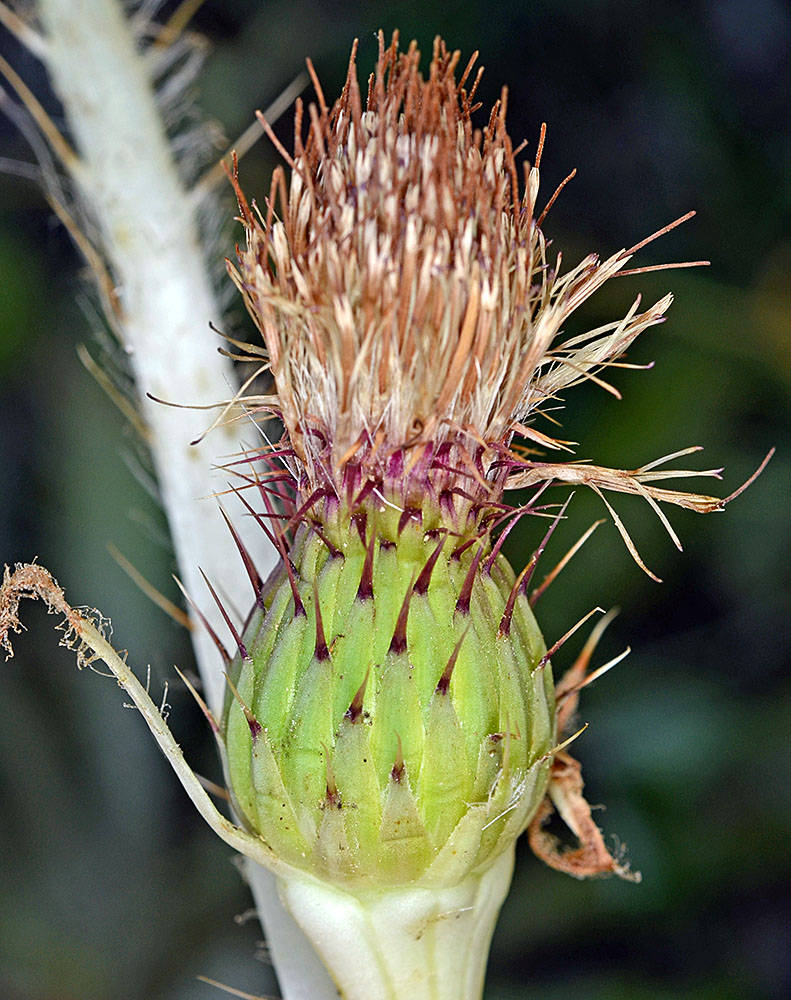Cirsium scariosum
Cirsium undulatum
dinnerplate thistle, elk thistle, meadow thistle
wavyleaf thistle
often acaulescent or short-caulescent, sometimes caulescent with a single bushy-branched stem; stout and fleshy, glabrous or sparsely arachnoid-tomentose.
1–several, white-tomentose.
linear to elliptic, 10–40 × 3–8 cm;
margins entire to deeply pinnately divided; plane or undulate;
spines usually thin to moderately thick, 2–15 mm;
surfaces abaxially glabrous to densely arachnoid-tomentose, adaxially glabrous to thinly tomentose or villous;
basal usually present at flowering, sessile or petiolate.
elliptic to ovate, 10–40 × 1–10(14) cm;
margins shallowly dentate to deeply pinnate, undulate;
spines 2–12 mm;
surfaces abaxially densely white-tomentose, adaxially glabrate to sparsely tomentose;
basal occasionally present at flowering, sessile, clasping, or petiolate.
ovoid to hemispheric, 1–3(4) × 1.5–6 cm, glabrous to thinly arachnoid-villous.
ovoid to campanulate, 2.5–4.5 × 1.5–4.5 cm, glabrate to thinly tomentose.
corollas 20–40 mm, white to purple, sometimes rose or pink-tinged;
tubes 9–22 mm;
throats 4–12 mm;
lobes 4–10 mm;
styles conspicuously exserted;
tips 3–8 mm.
corollas 24–50 mm, white to pale lavender or pink;
tubes 12–28 mm;
throats 6–14 mm;
lobes 7–13 mm;
style tips 5–7.5 mm.
imbricate; without glutinous ridges;
spines thin, 0–12 mm.
imbricate, with prominent glutinous ridges;
spines spreading to reflexed, 1.5–5 mm.
4–6.5 mm; light to dark brown, occasionally striate;
pappi 15–35 mm.
6–7 mm; light to dark brown;
pappi 20–40 mm.
1–many.
1–10.
Cirsium scariosum
Cirsium undulatum
Wet meadows, forest openings, sagebrush areas, pastures. Flowering Jun–Aug. 100–2000 m. BR, BW, Casc, ECas, Owy, Sisk, WV. CA, ID, NV, WA; north to British Columbia, northeast to Alberta, east to WY, southeast to NM, Quebec. Native.
Cirsium scariosum is known to hybridize with other native species where their ranges overlap.
Sagebrush areas, dry hillsides, prairies, disturbed areas, roadsides. Flowering May–Aug. 50–1400 m. Col, ECas, Lava, WV. CA, ID, NV, WA; north to British Columbia, northeast to Manitoba, east to MI, southeast to TX, south to Mexico, GA, PA. Native.
Bridget Chipman
Bridget Chipman
- Local floras:
BC,
CA,
OR,
WA
- Local Web sites:
CalFlora,
CalPhotos,
Flora NW,
PNW Herbaria,
Turner Photog.
WildflowerSearch
iNaturalist (observations)
USDA Plants Database
- LBJ Wildflower Center
- SEINet
- Plants of the World Online
- Encyclopedia of Life
- Wikipedia
- Google Image Search
- Local floras:
BC,
CA,
OR,
WA
- Local Web sites:
CalFlora,
CalPhotos,
Flora NW,
PNW Herbaria,
Turner Photog.
WildflowerSearch
iNaturalist (observations)
USDA Plants Database
- LBJ Wildflower Center
- SEINet
- Plants of the World Online
- Encyclopedia of Life
- Wikipedia
- Google Image Search





